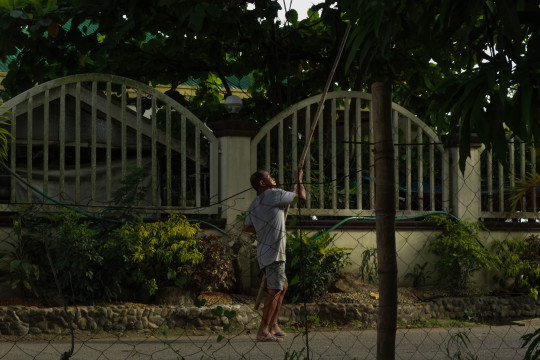Don't wanna be here? Send us removal request.
Text
The fruits of one's labor: harvesting into the lands of Upig
With the continuous increase of food prices in the market, Evelyn opted to be practical by using the resources available within their area in consuming fresh and healthy meals that saved her a fortune for the past years.

The Philippines is known as an agricultural country with its major products such as rice, coconut, corn, sugarcane, banana, pineapple, and mango. With Bulacan recognized as a contributor in producing a great amount of these products, its agricultural area is found to be maximized in mixed farming, diversified crops, irrigated rice paddy, and agroforestry. Along with its 36 existing provinces, San Ildefonso is focused on farming, raising of poultry or livestock, vegetable production, and marble processing.


A scenery of wide-ranging fields of agricultural land serves as a pathway entrance into Upig, a small barangay in San Ildefonso. Large and various crops of locally produced vegetables seem to occupy the lands. It is located nearby the community and accessible through walking distance. But, the liberty for accessibility of the people to the land is nonexistent since its pure business to the landowners. Hence, it is considered as an investment of property and a source of profit, and the people are restricted inside its premises. Evidently, only those powerful and wealthy families have the right and control over the resources—a clear manifestation of the society wherein ordinary individuals remain powerless and robbed of basic rights in exchange for self-centered profits.


Living in a rural community basic necessities are far away—local markets, malls, and other essentials require a doubled travel time to reach. It takes time and the difficulty of transportation is crystal clear. However, the convenience of fine and premium soil presently available throughout the land area of the community benefits the people including, Evelyn’s household.
“Mataba at maganda yung lupa, tiyaga at sipag na lang talaga sa pagtatanim” she said.
With the various fruits and vegetables planted at the back of their house, who would have thought pineapples can be found in Bulacan? She was honestly surprised by its growth. It was unexpected on her part since she just experimented and thought it can only be found in Tagaytay City. On the other hand, all of her plants grow healthily and produce continuously after every harvest.

The house being surrounded by years-old mango trees is one of the crowd’s favorites especially considering mango as the national fruit of the country with the exquisite taste it offers. In fact, they can freely pick the readily available herbs, vegetables, or seasonal fruits at any time of the day. Even the trees destroyed by the typhoon were used as fire logs.

The Philippine agriculture shrinking to 1.2% in 2020 and agricultural production dropping by -3.3% in the first quarter of 2021 caused the inflation along with thousands of jobs lost brought by the pandemic. But then, farming and growing beneficial crops exclusively for own consumption eases the financial burden.

In the case of Evelyn, it saved her a lot in their food expenses yet still gets the nutritional value. It also characterizes sustainability in providing food on the table. By growing up living in Upig, she basically acquired knowledge on farming. It became easier for her to take care of whatever she wishes to plant. Their family even invested in raising small quantities of poultry as an extra income.


It takes time and patience to produce the food served on the table with its long and back-breaking process yet, fulfilling in harvesting the fruits of one's labor. The convenience and sustainability Evelyn found in farming within the comfort of her home shed a light during the time of uncertainties brought by the struggles of living—beyond the capability of merely surviving, it developed into a lifestyle.
3 notes
·
View notes